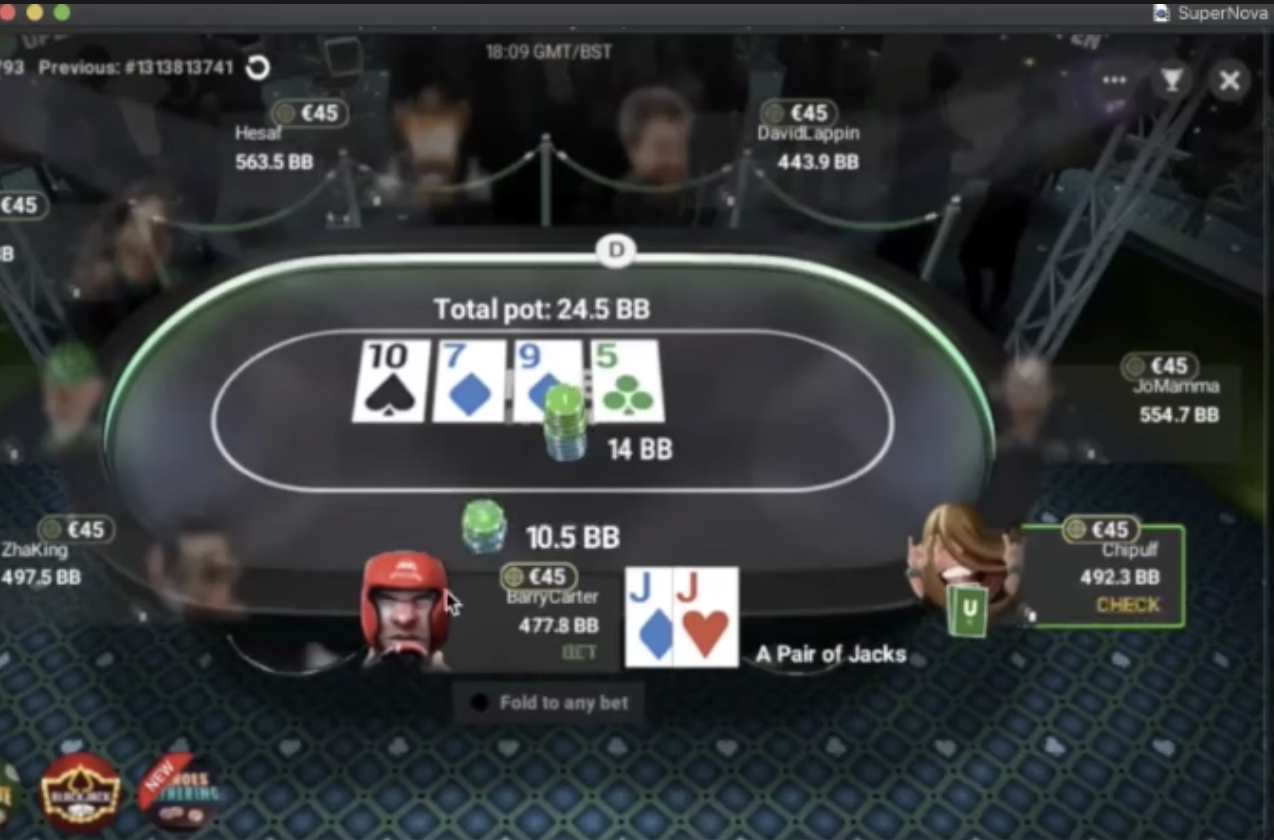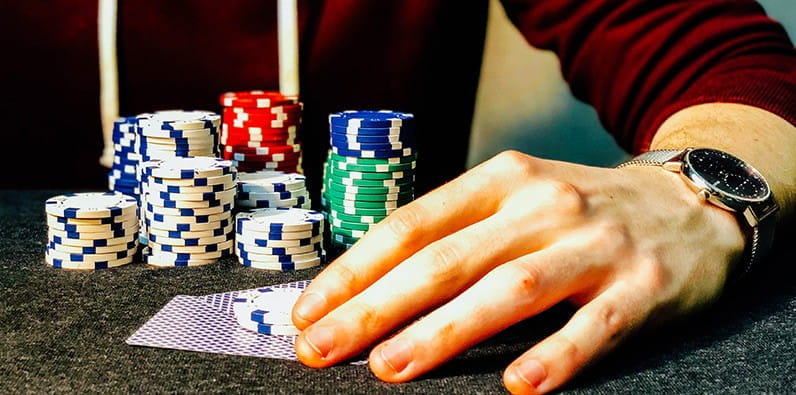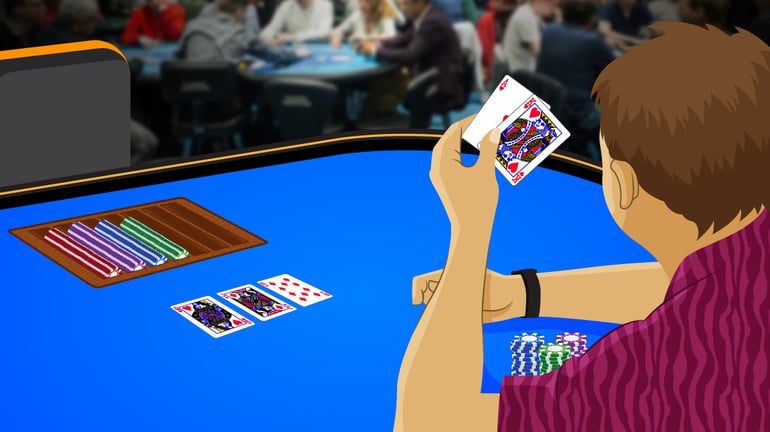Poker Nuts Check
Welcome to PokerDictionary.net. Confused by some of the poker terminology and lingo? This site is here to help you better understand the talk from opponents. You can find some of the best places to play at bestonlinecasinos.org.uk, but before you can master the game, you need to get familiar with all the poker terms and poker slang used by Texas Holdem players, both online and live.
Chances are if you’re an online poker player then you’ve heard of online poker sites that allow visitors to play anywhere and anytime you want. Every poker player should take advantage of the free money being given to you, as it will provide a healthy boost to your online poker bankroll which will no doubt come in handy while you’re still learning the game.
This page is a dictionary and glossary of 280+ poker terms and acronyms and counting. If you want to know what was meant by a “three-bet”, “continuation bet”, “donkey”, “squeeze play” or any other expressions used by the global poker playing community, you should browse through the poker dictionary below. Definitions include cross-links, real world examples, and related terms to help you dig deeper into the language of poker. Knowing the main poker terms will make analyzing and discussing poker hands with your friends a much easier task.
Glossary of Poker Terms: Alphabetical Listing
- 6-Max
- ABC Poker
- Ace High
- Ace Rag
- Action
- Active Player
- Add-on
- Air
- All In
- Alligator Blood
- Angle Shooting
- Ante
- ATM
- Avatar
- Baby Flush
- Backdoor
- Bad Beat
- Bad Beat Jackpot
- Badugi
- Bankroll
- Barrel
- BB
- Bet the Pot
- Betting Line
- Betting Pattern
- Big Bet Poker
- Big Blind Special
- Big Pair
- Big Slick
- Bitcoin Poker
- Black Friday
- Blind
- Blind Stealing
- Blocker
- Blocking Bet
- Bluff
- Bluff Catcher
- Board
- Bonus Rollover
- Bonus Whoring
- Bottom Pair
- Bounty
- Brick
- BRM
- Broadway Card
- Bubble
- Bum Hunting
- Burn Card
- Button
- Buy-In
- BvB
- BWCT
- Call
- Calling Station
- Cap
- Caribbean Stud Poker
- Cash Game
- Chase
- Chat Box
- Check
- Check Fold
- Check in the Dark
- Check Raise
- Chip Dumping
- Chip Leader
- Coffee Housing
- Cold Deck
- Collusion
- Combo Draw
- Community Card
- Computer Hand
- Continuation Bet
- Cooler
- Counterfeiting
- Cutoff
- Dead Man’s Hand
- Dead Money
- Deal It Twice
- Dealer
- Dominated
- Donk Bet
- Donkey
- Double Belly Buster
- Double Or Nothing
- Doyle Brunson
- Draw
- Draw Poker
- Drawing Dead
- Dry Board
- Early Position
- Effective Stack
- EP
- EPT
- Equity
- EV
- Face Card
- Face Up
- Fast Play
- Final Table
- Fish
- Fit or Fold
- Five of a Kind
- Float Play
- Flop
- Flush
- Flush Draw
- Fold
- Fold Equity
- Four of a Kind
- Four-Bet
- FPS
- Free Card
- Freeroll
- Full House
- Gambler’s Fallacy
- Garbage Hand
- Grinder
- GTD
- Gutshot
- Hand History
- Hand Odds
- Hand-for-Hand
- Heads-Up Poker
- Heater
- Hero Call
- High Card
- High Stakes Poker
- Hit and Run
- Holdem
- Home Game
- HORSE
- HU4Rollz
- HUD
- ICM
- Implied Odds
- Inducing
- IP
- Isolation Play
- ITM
- Jacks or Better
- Kicker
- LAG
- Late Position
- Lead
- Let It Ride Poker
- Levelling
- Limit Poker
- Limp
- LP
- Main Pot
- Maniac
- Metagame
- Micro Stakes
- Middle Pair
- Middle Position
- Misclick
- MP
- MTT
- Muck
- Multi-Accounting
- Multi-Tabling
- Nit
- Nitroll
- No Deposit Bonus
- Nosebleeds
- Nuts
- Omaha
- Omaha Hi/Lo
- One Pair
- OOP
- Open Raise
- Orbit
- Outs
- Overbet
- Overcall
- Overcard
- Overlay
- Overlimp
- Overrolled
- Pai Gow Poker
- Payout Structure
- PFR
- Pineapple Poker
- PLO
- Pocket Pair
- Poker Bot
- Poker Etiquette
- Poker Face
- PokerStove
- PokerTracker
- Position
- Postflop
- Pot Committed
- Pot Limit Omaha
- Pot Odds
- Preflop
- Preflop Aggressor
- Protect
- Rabbit Hunting
- Rack
- Ragged
- Railbird
- Rainbow Flop
- Rake
- Rakeback
- Range Merging
- Rank
- Re-Buy
- Results Oriented Thinking
- Ring Game
- River
- RNG
- Royal Flush
- Runner Runner
- Satellite
- SB
- Scare Card
- Semi-Bluff
- Set
- Shark
- Shootout
- Short Stack
- Short-Handed
- Showdown
- Side Pot
- Sit and Go
- Sitting Out
- Slow Play
- Slowroll
- Small Ball Poker
- Snapcall
- Speed Poker
- Spew
- Spin and Go
- Splash The Pot
- Split
- SPR
- Squeeze Play
- Stake
- Staking
- Starting Hand
- Steps Tournaments
- Stone Cold Bluff
- Straddle
- Straight
- Straight Draw
- Straight Flush
- String Bet
- Strip Poker
- STT
- Stud Poker
- Suckout
- Suited
- Suited Connectors
- Super Satellite
- TAG
- Tanking
- Tapping the Glass
- Tell
- Three Card Poker
- Three of a Kind
- Three-Bet
- Three-Bet Light
- Tilt
- Time Bank
- Top Pair
- Top Two
- Tournament
- Tournament Director
- TPTK
- Turbo
- Turn
- Two Pair
- UIGEA
- Underrolled
- UTG
- Value Bet
- Variance
- Verbal
- Video Poker
- VPIP
- Wait for Big Blind
- Walk
- WAWB
- Weak
- Wet Board
- Wild Card
- Winrate
- WPT
- Wrap
- WSOP
Poker Nuts Check Results

I hope you can put this poker lingo to good use in both speaking to other poker players, and understanding different aspects of the game. Poker lingo is an important tool in helping you to understand what advice others are giving. Additionally, if the other players at the table realize that you are not familiar with the poker terms then they might gauge that you are a new player.
Man can’t survive on poker lingo alone though, so please continue on through this website, and learn more about Texas Hold’em and other poker variants. If you have any questions or would like to submit a phrase request for a poker term that you are not familiar with and is not already on our site, please contact us at info @ pokerdictionary.net – New poker terms and acronyms are added to our site all the time, so check back often!
The thrill of flopping a monster is the nirvana of hold’em. This wonderful event makes mucking all that trash for hours on end worthwhile.
An engulfing ejaculation so powerful that it will not only blow your dickhead off, but it will stretch your dickhole so far that everything dribbles out and you can make hand signs with the excess skin. Add about 1 heaping tablespoons of my rub (ground fine if possible) per 1 cup of nuts or seeds and stir to coat evenly. Peanuts coated with my rub. Once all of the seeds and nuts are coated with the rub, they can be placed into a mesh grill topper or into Bradley racks or a cooling rack lined with foil.
Poker hand distribution is somewhat like a bell shaped curve, in that the hands that are total trash and the monsters are on either end, and the bulk of the more difficult ones to play, are in the middle. Does that mean that trash hands and the monsters are easy to play? The trash is a great deal easier to play than the monsters. Does that statement surprise you?
Let’s look a little closer at how one might play a monster hand for maximum value before we just conclude that “Hey, it’s a monster – all you need to do is raise, re-raise or go all-in”. There just may be other criteria to consider if we desire to make the most of our monsters.

Just a Monster or the Nuts?
When this wondrous event of flopping a monster occurs the first question you need to ask yourself is, “Do I have the absolute Brazils or do I have a monster that is only currently the nuts and can be overtaken?” An example of this phenomenon occurs when you flop the nut flush while an opponent flops a set with re-draws to quads or a full house. Notice the contrast when flopping quads with no straight flush or over card to the pair on the board.
While you need to be cognizant about the current nuts that are not the absolute Brazils, those unpleasant situations of being drawn out on only occur about as often as flopping the monster to begin with. However, in no-limit it’s just this type of situation that turns what appears to be nirvana into absolute hell as your whole stack disappears. Obviously you need to be acutely aware of the texture of the board and the betting action to determine whether your monster can be run down or not. Once that status is ascertained you can proceed accordingly.
SW Poker Card-Guard Coin Collectibles Table Games Poker - Good Luck w/Plastic Case, Las Vegas Good Luck Horseshoe/Shamrock Poker Coin Chip Card Guard Protector 4.6 out of 5 stars 15 $7.88. What Does Checking the Nuts Mean? The poker phrase means to check (or flat-call) your hand as the last player to act before a winner is decided, while being in possession of the best possible hand on the table. If you are the last to act on the river holding the best hand, you have to bet.

Should You Slow Play?
Poker Nuts Checken
Like so many poker questions the answer is, “it depends”. After assessing the potential vulnerability of your monster you need to determine how you can get the maximum value from it. Flopping a monster, getting too frisky and significantly over betting the pot only to have everyone fold would be a complete waste of a monster. You want your train to leave the station with passengers aboard – paying passengers. The dolts that win nothing more than the blinds don’t deserve to have monsters dealt to them. I hope the poker gods are reading this and taking note. If you determine that you are so far out in front of the pack that you’re safe, then by all means slow play and allow opponents to catch up a little. Give them some rope so they can hang themselves!
Utilize Your Current Table Image
Always be aware of how the rest of the table perceives you. Have you been playing fast poker or sitting there like a rock mucking hands for an hour? Your table image can be constantly changing as your run of cards may be dictating different actions that are interpreted by a newcomer as your style. Many players are very much aware of their general style of play but fail to monitor how the current run of cards, showdowns, etc, have made them appear to their opponents. Always be aware of your current table image so that you can take advantage of it.
The absolute best time to flop a monster is on the heels of having shown down a marginal hand that you may well have gotten out in front of and at the showdown a few eyebrows are raised concerning your loose play. Now, if on one of the next hands you’re fortunate enough to flop a monster, everyone wants a piece of you because they know that you’re playing trash. Oh, how I love to surprise them!
This is one very good reason why as tight as you might play you need to give the table an illusion of action so you can get your monsters paid off. This illusion of action is accomplished through the wider range of hands that you play in later position. Only your better opponents will factor in the position you played from correctly. Many poker players just react to the value of the hand that is showed down with the exception of blind play.
Position is a Key Consideration
Of course position is a key consideration, as it always is in poker. In terms of maximizing the value of your monster you need to get money into the middle while not chasing off your customers. In addition you need to make sure your play is not too cute and wind up being run down by an opponent that has good re-draws.
If you have shown aggressiveness pre-flop, received some callers, but are out of position when you flop your monster, it is often best to fire the continuation bet because your opponents expect it. They must have had something to call your pre-flop raise. To check hoping to get in a check raise often times looks suspicious plus you run the risk of having everyone check behind you. That will not accomplish your goal of getting chips in the pot. If you really have a strong monster, try betting out a third to a half of the pot, hope to get played back at and then make your next decision based upon stack sizes. If your opponent is pot committed you will be able to take his whole stack.
Assessing the Game Texture
Unless you have just sat down at the poker table and your very first hand is a monster, you should have developed a feel for both the texture of the game and your opponents’ tendencies to help guide your decision making. Is this group a frisky bunch or are you sitting in the middle of a rock garden?
If the table is mixed, which is the norm, then the position of your different opponents is critical to using them to achieve your goal of maximizing profit. As an example, if you’ve determined that the player on the button regularly attempts to thin the field through aggressive play post flop – go ahead and check your monster and allow the button to do your bidding. Conversely, if it’s checked to you and the only player behind you can best be described as the Rock of Gibraltar then you need to make a wager. As always, knowledge about how your opponents’ approach the game is a critical aspect of winning play.
Hand Example
Poker Nut Flush
Imagine you are sitting in the small blind in a $1/$2 no-limit cash game holding . An early player limps in as does a middle position player. The button now pops it to four times the big blind:
Figure 1
Nuts Poker Term
With limpers involved this raise gives you slightly more than 2-to-1 to make the call, which you do. Obviously you’re hoping to flop a set and realize you’re not getting the required odds to do so, but factoring in the implied odds, as well as the knowledge that if you don’t hit your hand you’ll be able to get away from it rather cheaply, convinces you to make the call. The blinds and limpers also call.
The-Flop

Poker Nuts Check Cashing
“Bless you poker gods”, you think as the flop comes giving you the second nut hand:
Figure 2
Only pocket 3’s can beat you and you know there isn’t a sniper behind every tree. You’re first to act and you need to decide whether you will slow play or lead out with a bet. Let’s look at the likely scenarios to decide what might be the best course of action.
If you check, in all likelihood the original limpers will check to the button who raised pre-flop, who in turn will make a continuation bet. If you then raise with your monster you will probably wind up heads up with the button after the two limpers fold.
If instead you bet out but make it a small bet which one or both of the limpers may call, you will be able to trap additional chips. Now when the button raises, you can come over the top because the limpers will most likely fold to the button’s raise anyway.
I vote for leading out with a modest bet. Ideally, the button has a flush draw such as and will feel committed to this flop with the nut flush draw. Even if all he has is an overpair to the board, he may be willing to go to war. When you are fortunate enough to flop a monster you need to visualize how the hand is likely to play out to figure how to best maximize your return.
Since it is much more prevalent to miss flops completely or just get a small part of it, flopping the nuts is a wonderful feeling. When the poker gods bestow this blessing upon you don’t squander it. Usually post flop you make decisions regarding the likelihood of your hand prevailing against the rest of the field. When you’re fortunate enough to flop a monster, your thoughts should be directed to how you can extract the maximum number of chips from your opponents. Filter your thoughts through the suggestions above before just pushing your chips forward.
Related Lessons
By Tom 'TIME' Leonard
Tom has been writing about poker since 1994 and has played across the USA for over 40 years, playing every game in almost every card room in Atlantic City, California and Las Vegas.
Poker Nuts Check Game
